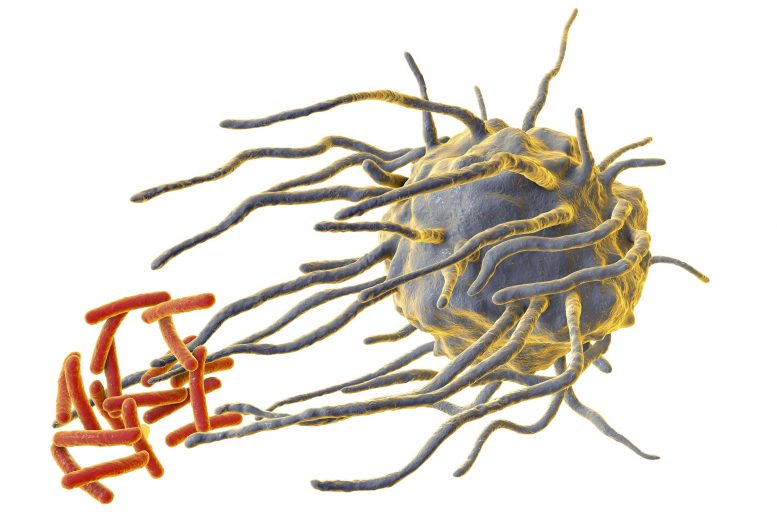
Macrophages, the killer cells of our immune system, are controlled by circadian rhythms, but the timing appears to rely upon an unexpected influence. Credit: Rensselaer Polytechnic Institute
An analysis of an exhaustive dataset on cells essential to the mammalian immune system shows that our ability to fight disease may rely more heavily on daily circadian cycles than previously assumed.
Malfunctions in circadian rhythms, the process that keeps our bodies in tune with the day/night cycles, are increasingly associated with diabetes, cancer, Alzheimer’s, and many other diseases. An investigation published today in Genome Research shows that the activity of macrophages — cells within us that seek and destroy intruders like bacteria — may time daily changes in their responses to pathogens and stress through the circadian control of metabolism.
In this study, Jennifer Hurley, the Richard Baruch M.D. Career Development Assistant Professor of Biological Sciences at Rensselaer Polytechnic Institute and senior author on this study, and her team investigated how the levels of RNA and proteins in macrophages change over two days. “We have shown there is an incredible amount of circadian timing of macrophage behavior, but the clock is timing macrophages in unexpected ways,” said Hurley.
The circadian system is comprised of a set of core clock proteins that anticipate the day/night cycle by causing daily oscillations in levels of enzymes and hormones, and ultimately affecting physiological parameters such as body temperature and the immune response. This molecular clock marks time through a self-regulating cycle of protein production and decay. The “positive” element proteins of the clock trigger production of the “negative” element proteins, which in turn block production of positive element proteins until the negative element proteins decay, thus creating a negative feedback cycle that occurs once every 24 hours.
Positive element proteins also regulate fluctuations in a substantial number of gene products, known as messenger RNA or mRNA. Genetic instructions are transcribed from DNA to mRNA, which are then used as a recipe for assembling proteins, the functional building blocks of the cell. It has long been assumed that the levels of each subsequent step could be predicted from the previous. If that were the case, oscillating mRNA would correspond with oscillating levels of cellular proteins, and therefore, if one could track mRNA, they would know what proteins the circadian clock controlled in the cell.
However, this investigation showed that this paradigm may not always be true. The analysis of the macrophage dataset revealed that there was a substantial mismatch between the proteins and mRNAs that are controlled by the circadian clock. This data paralleled research published in Cell Systems in 2018 by the Hurley lab, showing that about 40% of oscillating proteins in the fungus and circadian model system, Neurospora crassa, had no corresponding oscillating mRNA.
“But the scale of the difference in macrophages really surprised us,” Hurley said. “Eighty percent of the proteins that oscillate don’t have associated oscillating mRNA in macrophages. That means we were really missing how the clock was timing immunity.”
Watch a video on Hurley’s research:
Hurley’s team, in collaboration with the lab of Annie Curtis at the Royal College of Surgeons in Ireland (RCSI), was able to predict and then demonstrate that the clock regulated metabolism to time key immune functions in macrophages. To do so, researchers from RCSI tracked the energy-generating mitochondria of macrophages, showing the rhythm with which the organelles split apart to generate energy and re-unite in a resting stage. Then the Hurley lab was able to show that the timing of key immune processes was controlled by the changes in energy production that resulted from the splitting and fusing of the mitochondria.
“Our data points to the need to track rhythms on a whole new level,” Curtis, senior lecturer at RCSI, said. “It also means that our bodies are timed by our circadian clocks more than we thought.” This circadian timing of the immune system has implications for human health, disease treatment, and vaccine efficacy.
Reference: “Post transcriptional Circadian regulation in Macrophages Organizes Temporally Distinct Immunometabolic States” by Emily J. Collins, Mariana P. Cervantes-Silva, George A. Timmons, James R. O’Siorain, Annie M. Curtis and Jennifer M. Hurley, 12 January 2021, Genome Research.
DOI: 10.1101/gr.263814.120
“Post transcriptional Circadian regulation in Macrophages Organizes Temporally Distinct Immunometabolic States” was published with support from the National Institutes of Health, the Department of Energy, the Consejo Nacional de Ciencia y Tecnología, and the Science Foundation Ireland. At Rensselaer, Hurley was joined in the research by Emily J. Collins. Annie M. Curtis led the research at the Royal College of Surgeons in Ireland and was joined there by Mariana P. Cervantes-Silva, George A. Timmons, and James R. O’Siorain.









Interesing.
Time is a relative concept. Always wonderred why tere are so many different Calenndars in different Cultures on the Planet. Has the Circadian regulation adjusted to the Calendars ( Time on a Yearly Basis) and gives immunity to certain Cutures which is superior to the Standadrdized Global Gregorian Calendar we all follow and use.
Circadian regulation may be driven by extra-planetary forces in the Univese with probable maximum impact from planetary objects near the third rock from the sun on which we exist. Circadian regulation will not necessariy depend on the 24 hour Time Cycle on Planet Earth. Or the Sicty Minutes Division of Time into an Hour, or even the sixty second division of a Minute intoSeconds. Time at the Quantum level may be on a completely different scale as Compared to Timeat the Gross Level.
There are distant obhects in the Unvesre which are much more massive compared to earth (Mass) and the Circadian regulation of objects and life forms (if they exist) will be dictated by their SUNS and Revolution around the same. The mathematics of these biological creatures with Circadian regulation (if they exist) is barely understood by Science.
There are Many processes in the Biological , Chemical and Physical Sciences which are also barey understood by Scientists who specialise in certain dsiciplines of Science and gain knowledge of more and more about Less and Less!
Opinions expressed are personal and not binding on anyone.
Best of Luck in taking the research forward. Based on data and analysis as well as Syntheisis of macro from the micro and the Nano.